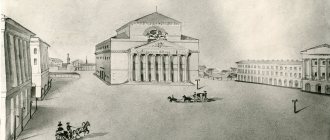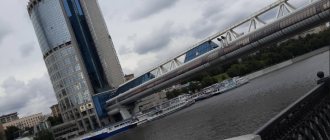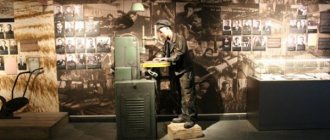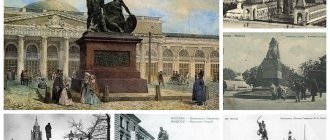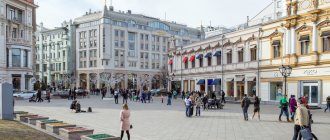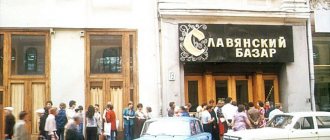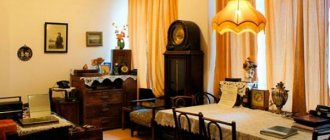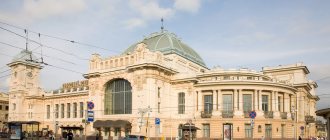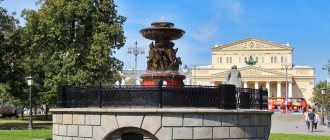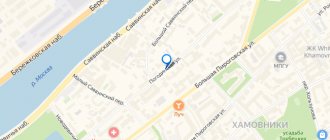| Monument | |
| Monument to A. N. Ostrovsky | |
| Monument to A. N. Ostrovsky near the Maly Theater building | |
| A country | Russia |
| City | Moscow, Theater Square |
| Sculptor | N. A. Andreev |
| Architect | F. O. Shekhtel |
| Construction | 1926-1929 |
| Material | bronze, granite |
Monument to A. N. Ostrovsky
- a monument to the writer Alexander Nikolaevich Ostrovsky. Installed in Moscow on Teatralnaya Square in front of the Maly Theater in 1929. The sculptor is Nikolai Andreev, the architect is F. O. Shekhtel[1]. The monument is made of bronze and is located on a granite pedestal.
Story
The idea of creating a monument to A. N. Ostrovsky belongs to the Society of Russian Dramatic Writers and Opera Composers[2]. The space in front of the Maly Theater was chosen as the location for the monument, since most of the writer’s plays were staged on its stage. Fundraising for its construction was completed back in 1918, but construction had to be postponed due to the revolution[2].
In 1923, the centenary of the birth of Alexander Ostrovsky was celebrated. On this occasion, on April 13, the first stone was laid for the future monument to the great Russian playwright. A competition for the best project was also announced. As a result of this competition, the author of the monument was the sculptor Nikolai Andreev. Together with his brother Vyacheslav, also a sculptor, Andreev studied hundreds of photographs of Ostrovsky[2]. While working, Nikolai Andreev suffered from pneumonia, but did not stop working on the monument. Work continued until 1928. The process of casting the monument in bronze was delayed and its opening was postponed to 1929[3]. The project for the monument's pedestal is one of the last works of the architect F. O. Shekhtel. The work on the construction of the pedestal according to Shekhtel’s design was carried out after his death by the architect I. P. Mashkov[1][4].
On May 27, 1929, the monument was unveiled in the presence of party and government members on Sverdlov Square (now Teatralnaya) in Moscow[5].
What memorable places in Moscow are associated with the name of Ostrovsky?
What memorable places in Moscow are associated with the name of A.N. Ostrovsky?
Malaya Ordynka, house number 9 on Golikovsky Lane.
Golikovsky Lane is located at right angles to Pyatnitskaya Street, and the other end abuts the Church of St. Clement (XVIII century). At the beginning of the 19th century. Nobles lived here, and then commoners and merchants. At that time, this was a very green corner of Moscow: a chain of gardens stretched along Pyatnitskaya Street and Golikovsky Lane. If Pyatnitskaya Street consisted mainly of stone merchant houses, then in Golikovsky Lane the houses were wooden. On the corner of the alley and Pyatnitskaya street on the 19th century plan. there is a police box where a guard stood day and night, a guardian of order, such as the police officer Tigry Lvovich Lyuty from the play “There wasn’t a penny, but suddenly there was an altyn.” In a house in the courtyard of the Church of the Intercession, which belonged to the deacon of this church, N.F. Ostrovsky, the writer's father, rented an apartment at the end of 1822. The Ostrovsky family lived on the top floor. Here, on March 31, 1823, at four o’clock in the morning, Alexander Nikolaevich Ostrovsky was born. Now the House-Museum of A.N. is located here. Ostrovsky (branch of the State Central Theater Museum).
Gradually, the Ostrovsky family grew: several more children appeared - Natalya (1824), Mikhail (1827), Sergei (1829), and Nikolai Fedorovich bought his own house in Monetchiki, which was part of the Pyatnitskaya part, but by the beginning of the 30s. and it turned out to be too small for a large family, and the Ostrovskys moved to a large house on Zhitnaya Street (house No. 8, not preserved). The family changed their place of residence, but all the moves did not go beyond the borders of Zamoskvorechye. About Zamoskvorechye A.N. Ostrovsky wrote: “And wherever you come from, man, now you will know that we are having a holiday. Firstly, because you will know that you will hear a thick and continuous ringing throughout Zamoskvorechye. Secondly, because you will know that the whole Zamoskvorechye region smells of pies.”
Pyatnitskaya Street is one of the large shopping streets, “one of the veins of Zamoskvorechye” (Ap. Grigoriev), into which many alleys flow, for example Bolvanskie Lanes, or simply Bolvanka. In “Notes of a Zamoskvoretsky Resident,” Ostrovsky writes: “...They say that there are places there that are scary to live. Why is it scary? - you ask. But they will tell you why: there is a place there called Blank. Why is she a Dummy? Because the Tatar god stood, in our words - an idol, and in Tatar - a blockhead. So, please, live in this place. In such places, owners refuse houses, no one buys, and it’s terrible to live there.”
Ostrovsky also describes the Zatsepsky market, the poor official Balzaminov speaks about it in the comedy “What you go for is what you will find”: “What ignorance is rampant in our side, passion!.; They don’t understand the appeals, there is no humanity. Walk through the market past the shops one more time - now they will give you a nickname, some nickname. At almost every gate there are coachmen sitting, as fat as butchers; All they do is pet the dogs and play with them, and dogs, Mama, are like lions.”
In 1835 A.N. Ostrovsky was assigned to the 1st Moscow gymnasium, located on Volkhonka (house no. 16-18). Ostrovsky's knowledge of Moscow became wider and wider.
In April 1840, the writer’s father acquired a new property - on Bolshoi Nikolovorobinsky Lane (now on the site of houses No. 3-9 on Serebryanichesky Lane). Here, on a large area overlooking the Yauza on one side, there were five residential and several non-residential buildings. The Ostrovsky family lived in a large two-story house. Clients-merchants came here to visit the playwright’s father, and cases of bankrupts were considered here.
Moscow University, located on Mokhovaya Street, is also associated with the name of Ostrovsky. Here the writer studied at the Faculty of Law in 1840-1843. Here on Mokhovaya Street (house No. 7, not preserved) the Moscow Commercial Court was located, in which A.N. Ostrovsky served from 1845 to 1851. Conscientious Court, in which A.N. Ostrovsky served previously and was located in the Public Offices building on Voskresenskaya Square.
Since the late 1840s. Ostrovsky devotes his life to literature and theater. Remembering these years, Apollo Grigoriev wrote: “Ostrovsky appeared, and around him there was a circle as a center.” This circle included Ostrovsky’s schoolmate, poet and translator N.V. Berg, a young actor, a wonderful storyteller I.F. Gorbunov, Ap. Grigoriev, composer A.I. Dubuc, poet L.A. May, artist Pr.M. Sadovsky. Often the circle meetings took place in Ap's house. Grigoriev on Malaya Polyanka (house no. 12) or on Elokhovskaya street (house no. 2) in the government apartment of L.A. Mey, who in the early 1850s. was an inspector at the 2nd Moscow Gymnasium.
Speaking about Moscow during the time of A.N. Ostrovsky, one cannot fail to mention Pchelkin’s coffee shop, located opposite the Historical Museum, which played a significant role in the literary and theatrical life of Moscow. It occupied the second floor of the two-story house of the merchant Goryunov, built back in 1782. In the evenings, professors and students of Moscow University, writers, actors of the Maly Theater gathered here to discuss literary novelties and new theatrical productions. V.G. has been here Belinsky, A.I. Herzen, T.N. Granovsky, A.N. Ostrovsky, M.S. Shchepkin, Pr.M. Sadovsky, I.F. Gorbunov and others. “Who knows how much Pchelkin’s coffee shop spread throughout Rus' true love for science and art,” recalled A.A. Fet.
In the winter of 1849-1850, an event in the literary life of Moscow was the reading of A.N.’s comedy. Ostrovsky “Our people - we will be numbered!”
On November 3, 1849, Ostrovsky read his play at M.P. Pogodin, in his house on Devichye Pole (Pogodinskaya St., house No. 10-12). Back in the mid-1830s. historian M.P. Pogodin bought himself a house on Devichye Pole, and in the 1850s. built an outbuilding there in the form of a Russian hut. Various literary evenings were held here.
A.N. had friendly relations. Ostrovsky with many Russian writers and actors: he also visited the house of L.N. Tolstoy in Khamovnichesky Lane (Lva Tolstoy Street, building No. 21), and in the house of the famous Maly Theater actress E.N. Vasilyeva, one of the best performers of female roles in the playwright’s plays (Ostozhenka, house No. 4), and in other famous houses in Moscow.
The last years of A.N.’s life Ostrovsky are associated with house No. 14 on Volkhonka. In 1877, the playwright rented a large and comfortable apartment here in the house of S.M. Golitsyn. It was a luxurious mansion, in which in 1865 S.M. Golitsyn opened one of the first public museums. It consisted of an art gallery, a department of antiquities and a library. The museum existed until 1886, and then was sold at auction. A significant part of his collection ended up in the St. Petersburg Hermitage. A.N. also occupied an apartment in this house. Ostrovsky. A.F. visited the playwright here. Pisemsky, I.F. Gorbunov, I.S. Turgenev, P.I. Tchaikovsky, N.A. Rimsky-Korsakov, many artists of the Maly Theater. “The Dowry,” “Talents and Admirers,” “The Heart is Not a Stone,” and other plays were completed in Golitsyn’s house.
Expecting to get a government apartment after the summer holiday, A.N. On May 17, 1886, Ostrovsky settled in the Dresden Hotel on Tverskaya Street (on the site of modern house No. 6). He suffered severe attacks of angina pectoris here, and on May 28 he left for his estate in Shchelykovo, where he died on June 2, 1886.
The whole life of A.N. Ostrovsky was associated with the Maly Theater, which is now called the Ostrovsky House.
There are two monuments to the playwright in Moscow. The first is on Theater Square in front of the State Academic Maly Theater (sculptor N.A. Andreev, architect I.P. Mashkov, installed in 1929), the second is on Malaya Ordynka Street, 9, in front of the A.N. House Museum . Ostrovsky (sculptor G.I. Motovilov, architect L.M. Polyakov, installed in 1954).
Notes
- ↑ 1 2 Brandenburg B. Yu., Tatarzhinskaya Ya. V., Shchenkov A. S.
Architect Ivan Mashkov. - M.: Russian Book, 2001. - P. 67. - 136 p. — ISBN 5-268-00413-1. - ↑ 123
[www.camper-shoes.ru/content/progulki-po-moskve-pamyatnik-ostrovskomu Walking around Moscow: monument to Ostrovsky] - [www.planengo.ru/place/pamyatnik_anostrovskomu/more Monument “A. N. Ostrovsky"]
- Kirichenko E. I.
F. O. Shekhtel. Life. Images. Ideas. - M.: Progress-Tradition, 2011. - P. 344. - 360 p. — ISBN 978-5-89826-374-4. - [www.intomoscow.ru/modules.php?name=Contentp&pa=showpage&pid=7&cid=a Monument to Ostrovsky]
Excerpt characterizing the Monument to Ostrovsky (Moscow)
After the Battle of Borodino, the enemy’s occupation of Moscow and its burning, historians recognize the most important episode of the War of 1812 as the movement of the Russian army from the Ryazan to the Kaluga road and to the Tarutino camp - the so-called flank march behind Krasnaya Pakhra. Historians attribute the glory of this ingenious feat to various individuals and argue about who, in fact, it belongs to. Even foreign, even French historians recognize the genius of the Russian commanders when speaking about this flank march. But why military writers, and everyone after them, believe that this flank march is a very thoughtful invention of some one person, which saved Russia and destroyed Napoleon, is very difficult to understand. In the first place, it is difficult to understand wherein lies the profundity and genius of this movement; for in order to guess that the best position of the army (when it is not attacked) is where there is more food, it does not require much mental effort. And everyone, even a stupid thirteen-year-old boy, could easily guess that in 1812 the most advantageous position of the army, after the retreat from Moscow, was on the Kaluga road. So, it is impossible to understand, firstly, by what conclusions historians reach the point of seeing something profound in this maneuver. Secondly, it is even more difficult to understand exactly what historians see as the salvation of this maneuver for the Russians and its detrimental nature for the French; for this flank march, under other preceding, accompanying and subsequent circumstances, could have been disastrous for the Russians and salutary for the French army. If from the time this movement took place, the position of the Russian army began to improve, then it does not follow from this that this movement was the reason for this. This flank march not only could not have brought any benefits, but could have destroyed the Russian army if other conditions had not coincided. What would have happened if Moscow had not burned down? If Murat had not lost sight of the Russians? If Napoleon had not been inactive? What if the Russian army, on the advice of Bennigsen and Barclay, had given battle at Krasnaya Pakhra? What would have happened if the French had attacked the Russians when they were going after Pakhra? What would have happened if Napoleon had subsequently approached Tarutin and attacked the Russians with at least one tenth of the energy with which he attacked in Smolensk? What would have happened if the French had marched on St. Petersburg?.. With all these assumptions, the salvation of a flank march could turn into destruction. Thirdly, and the most incomprehensible, is that people who study history deliberately do not want to see that the flank march cannot be attributed to any one person, that no one ever foresaw it, that this maneuver, just like the retreat in Filyakh, in the present, was never presented to anyone in its entirety, but step by step, event by event, moment by moment, flowed from a countless number of very diverse conditions, and only then was presented in all its entirety, when it was completed and became the past. At the council in Fili, the dominant thought among the Russian authorities was a self-evident retreat in a direct direction back, that is, along the Nizhny Novgorod road. Evidence of this is that the majority of votes at the council were cast in this sense, and, most importantly, the well-known conversation after the council of the commander-in-chief with Lansky, who was in charge of the provisions department. Lanskoy reported to the commander-in-chief that food for the army was collected mainly along the Oka, in the Tula and Kaluga provinces, and that in the event of a retreat to Nizhny, food supplies would be separated from the army by the large Oka River, through which transportation in the first winter was impossible. This was the first sign of the need to deviate from what had previously seemed the most natural direct direction to Nizhny. The army stayed further south, along the Ryazan road, and closer to the reserves. Subsequently, the inaction of the French, who even lost sight of the Russian army, concerns about protecting the Tula plant and, most importantly, the benefits of getting closer to their reserves, forced the army to deviate even further south, onto the Tula road. Having crossed in a desperate movement beyond Pakhra to the Tula road, the military leaders of the Russian army thought to remain near Podolsk, and there was no thought about the Tarutino position; but countless circumstances and the appearance again of French troops, who had previously lost sight of the Russians, and battle plans, and, most importantly, the abundance of provisions in Kaluga, forced our army to deviate even more to the south and move to the middle of the routes for their food supplies, from the Tula to the Kaluga road, to Tarutin. Just as it is impossible to answer the question of when Moscow was abandoned, it is also impossible to answer when exactly and by whom it was decided to go to Tarutin. Only when the troops had already arrived at Tarutin as a result of countless differential forces, then people began to assure themselves that they had wanted this and had long foreseen it.
There remains intrigue around the installation of a monument to Vakhtangov near the theater named after him
Near the main entrance, right next to the columns of the historical building, a place has already been fenced off with metal barriers - this is where the bronze Evgeniy Bagrationovich will be located. Workers are preparing a reinforced concrete base measuring 3 by 3.5 meters; granite slabs will later be laid on it and the monument itself will be installed.
“We started about a year ago,” theater director Kirill Krok tells me. — It took so much time to prepare all the technical documentation, create and approve the layout, and get it approved by various authorities. And now the work has entered the final stage - the monument is being cast in soft material to its full size. When this option is finally agreed upon by us, bronze casting will begin.
A team of authors under the leadership of the famous sculptor Alexander Rukavishnikov is working on the embodiment of Vakhtangov’s image. It also included the architect Igor Voznesensky and, importantly, the main artist of the theater Maxim Obrezkov. It is especially worth emphasizing the fact that the theater makes the monument to its founder exclusively at its own expense.
— About 25 million rubles will be spent on all work - from the start to the installation of the monument. That is, there is not a single state penny here; all the funds invested in this project were earned by the theater itself,” confirms the director.
-Still, I would like to understand what Evgeniy Bagrationovich will look like?
-We want to maintain the intrigue until the opening of the monument. I can only say that it will be Vakhtangov in an informal, unusual form.
-In that case, will we recognize him? In all the photos he is a handsome, gracefully built man, such a romantic image.
-We’ll find out, because the monument was made based on a historical photograph from 1911-13 (though there is no exact date). It dates back to the period when Evgeniy Bagrationovich, together with his teacher Leopold Sulerzhitsky, vacationed in the Crimea, in Yevpatoria.
Yes, at the beginning of the last century, Evgeny Vakhtangov was listed as an actor in the troupe of the popular Moscow Art Theater, but even then he clearly showed himself as an author, director and musician, participating in the cabaret “The Bat” and “Stray Dog”. He was already taking the first steps to create his own theater studio, although the management of the Moscow Art Theater categorically did not allow him to work on the side. Talented students, high-profile performances, resounding success, and public adoration awaited him ahead.
And even more so, he hardly thought and hardly knew that his studio, consisting of passionate and obsessed amateur students, would one day become the most famous theater in the country and live to see its centenary. Nevertheless, the fact remains: Vakhtangovsky today is a success, brilliant sold-out performances, a talented troupe and the largest number of tours abroad. And the bronze statue of its creator will stand exactly in the center of the façade of the theater building in the opening of the architectural portal. It will be clearly visible from everywhere, and in the evenings it will also be illuminated.

